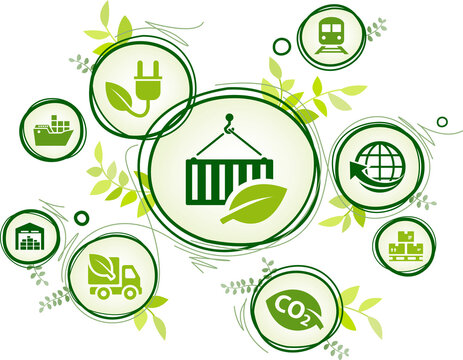
30 Sep How Does ESG & Sustainability Affect Supply Chain Management?
Dearest Friends,
I’ve had more discussions around supply chains in the last two and half years than I’ve had in my entire career combined! One of the many lessons the pandemic taught us is that supply chains are global, interdependent, and fragile. And, with increasing environmental disasters like hurricanes, heatwaves, fires, and floods, climate change also heavily impacts global supply chains.
So, unsurprisingly, Environmental, Social, and Governance (“ESG”) and Sustainability factors are increasingly gaining importance in supply chain management. Many companies are now looking at ways to improve their ESG performance to reduce compliance and regulatory risk and increase efficiency.
But what do ESG and Sustainability mean for supply chains? And how can businesses make sure they’re taking it into account? In this newsletter, we’ll explore the impact of ESG/S on supply chains and offer advice for improving performance.
Why is ESG important for supply chain management?
A company’s Environmental, Social, and Governance practices (“ESG”) can significantly impact its supply chain. For example, a company that uses child labor in its manufacturing process will likely face reputational damage if consumers discover this. This, in turn, could lead to a decline in sales and poor overall financial performance. Conversely, a company with solid ESG practices can build a positive reputation with consumers, boosting sales and creating long-term shareholder value.
In addition, good ESG practices can help attract and retain high-quality employees and lower a company’s risk of disruption from environmental disasters. As such, it is evident that ESG should be a key consideration for any company that wishes to manage its supply chain effectively.

How does Sustainability affect the Supply Chain?
Sustainability has become an increasingly important consideration for businesses in recent years. Consumers have become more aware of their purchases’ environmental and social impact, so they have begun to demand more sustainable products and services. In response, companies have made sustainability a priority throughout their operations, from the sourcing of raw materials to the packaging and delivery of finished products.
The supply chain is a critical component of any business, and companies must take a holistic approach to sustainability. This means considering a product’s entire lifecycle, from raw material extraction to disposal or recycling. It also means engaging with suppliers and other partners to ensure they adhere to sustainable practices. By taking these steps, companies can minimize their environmental impact and ensure that their products meet the demands of today’s and tomorrow’s consumers.

What does ESG stand for in procurement?
ESG is a set of standards companies can use to measure their performance in these critical areas. Many procurement organizations are beginning to require that their suppliers meet minimum ESG standards to be considered for contracts. This is because ESG criteria can significantly impact a company’s bottom line, reputation, and risk profile.
For example, environmental violations can lead to hefty fines, and poor social practices can damage a company’s reputation. By requiring their suppliers to follow more robust ESG metrics, procurement organizations can help to ensure that they are doing business with responsible companies. In the long run, this will help to protect the organization’s bottom line and reputation.

How is ESG affecting companies?
The rise of ESG investing has been one of the most significant trends in the financial industry over the past decade, especially for publicly traded companies. But sustainability and transparency are now being sought by private companies as well. And there’s no sign of it slowing down. According to a recent survey by JPMorgan, more than 60% of institutional investors now consider ESG factors when making investment decisions. This is having a significant impact on the way companies operate.
To attract investment, companies are increasingly focused on reducing their environmental impact and promoting racial and gender diversity. They’re also putting more emphasis on corporate governance and shareholder rights. As a result, we see a shift in the business landscape, with companies increasingly committed to sustainable and responsible practices.
What is sustainable supply chain management?
Sustainable supply chain management is a business process considering the Environmental, Social, and Governance (ESG) risks of the products or services being supplied. The goal is to improve the long-term health and viability of the supply chain by minimizing negative ESG impacts and maximizing positive ones.
This can be accomplished through various means, such as using recycled materials, supporting eco-friendly initiatives, or investing in renewable energy sources. While sustainable supply chain management can be more costly and time-consuming than traditional methods, it provides significant benefits for businesses and society.
In addition to reducing environmental damage, sustainable supply chain management can lead to improved working conditions, increased social responsibility, and enhanced reputation. As more consumers become aware of the importance of transparency, global supply chains are likely to take ESG considerations more seriously.
What is supplier ESG?
Supplier ESG is a framework that evaluates ESG risks and opportunities associated with an organization’s supply chain operations. Supplier ESG aims to help organizations identify and manage these risks and opportunities in a way that protects and enhances value for all stakeholders.
To do this, organizations need to clearly understand their ESG risks and opportunities and those of their suppliers. Supplier ESG helps to provide this understanding by assessing the ESG performance of suppliers across a range of indicators. These indicators can be divided into three broad categories:
1. What is their impact on the environment?
2. How are they treating their workforce and the communities in which they operate?
3. How equitable is their management structure?
By understanding the supplier’s ESG performance on these indicators, organizations can identify which suppliers pose the most significant risks and opportunities and take steps to mitigate or realize them accordingly. In this way, supplier ESG helps organizations to build more sustainable and resilient supply chain networks.

What are the three elements of supply chain sustainability?
There are three critical elements of supply chain sustainability: reducing environmental impacts, improving social and labor conditions, and ensuring ethical practices throughout the supply chain.
1. Reducing environmental impacts involves minimizing the use of resources, maximizing recycling and reuse, water and wastewater management, and working to reduce greenhouse gas emissions (GHGs).
2. Improving social and labor conditions means ensuring that workers are treated fairly, have access to safe working conditions, and receive a living wage.
3. Company operations look at how an organization is governed and managed. This includes board diversity, executive compensation, and shareholder rights.
By focusing on these three critical elements of their product and service suppliers, companies can help to make their supply chains more sustainable and improve their business performance.

What are some benefits of improved sustainability of a supply chain?
Sustainability efforts in a supply chain benefit the business and its stakeholders. Here are some key benefits:
1. Attract and retain employees
Millennials are now the largest generation in the workforce, and they are increasingly interested in working for companies that share their values. By working towards a more sustainable chain, a company can attract better employees and retain them long-term.
Furthermore, sustainable practices can help to create a positive work environment and build employee morale.
2. Build relationships with suppliers
As sustainability becomes more important to companies, suppliers who can provide sustainable products and services will have a competitive advantage. Companies can build strong relationships to improve quality and lower prices by working with sustainable suppliers.
3. Protect the environment
Ultimately, one of the essential benefits of sustainability is that it helps to protect our environment. Companies can significantly and positively impact our planet’s health by reducing waste, conserving resources, and supporting renewable energy sources.
4. Reduce costs
When done correctly, sustainability initiatives can help cut costs by reducing waste, improving efficiency, and developing new sources of revenue. For example, companies can save energy and raw material costs by investing in energy-efficient equipment or reducing packaging.
5. Create opportunities for innovation
Sustainability factors create opportunities for innovation in a company’s supply chain strategy. Developing new technologies and processes for a sustainable future is essential for continued economic growth. It is also an opportunity for businesses to differentiate themselves from their competitors. In today’s increasingly transparent global economy, sustainability is no longer just a “nice-to-have”; it is increasingly seen as a “must-have.” By investing in sustainability, businesses can position themselves as leaders in the emerging circular economy.
6. Reduce potential risks
Another benefit of sustainability is that it reduces risk. Many environmental problems, such as climate change, water scarcity, and air pollution, pose significant business risks. Businesses can mitigate these risks and protect their operations from disruptions by becoming more sustainable. This also includes countering active threats. In addition, sustainable practices can help companies build resilience in natural disasters. By investing in sustainability, companies can safeguard their future success and become supply chain leaders.

What are the most common supply chain risks?
Many risks can disrupt a supply chain. Here are five of the most common:
1. Natural disasters such as floods, hurricanes, and earthquakes can damage infrastructure, destroy inventory, and disrupt transportation.
2. Suppliers’ political instability can lead to customs delays, higher shipping costs, and product shortages.
3. Trade disputes can disrupt the flow of goods and raise costs for companies that rely on imports and exports.
4. Transportation disruptions such as port strikes or fuel shortages can delay shipments and impact customer service levels.
5. IT failures can cause order delays, inventory inaccuracies, and supply chain disruptions.
Companies must have a robust risk management strategy to mitigate supply chain risks. This should include supplier diversification, inventory management, and contingency planning.
How do you ensure supplier sustainability?
To ensure supplier sustainability, businesses should adopt a powerful ESG strategy when choosing suppliers. Additionally, companies can require that suppliers disclose their ESG practices and adhere to specific standards. Furthermore, businesses can create internal guidelines for sustainable sourcing and work with other companies to advocate for sustainable and resilient supply chains. By taking these steps, businesses can help ensure that their suppliers are environmentally and socially responsible.
Conclusion on Supply Chain Management
Sustainability is an increasingly important consideration for businesses regarding their supply chains. By implementing sustainable practices, companies can reduce costs, create opportunities for innovation, and reduce risks. In addition, by working with suppliers embracing sustainability, businesses can progress to an entire supply chain that is environmentally and socially responsible.

Supply Chain FAQs
What are corporate supply chains?
A corporate supply chain is a system of organizations, people, technology, activities, information, and resources involved in moving a product or service from supplier to customer. The action transforms natural resources, raw materials, and components into a finished product delivered to the end customer.
How is the supply chain related to the value chain?
Logistics can undoubtedly impact the value chain, as it plays a role in production and distribution. Regarding production, logistics can help determine the most efficient way to use resources and create products. Regarding distribution, logistics can help ensure that products are delivered to customers promptly and cost-effectively. Logistics can have a significant impact on a corporate value chain.
How can a company control supply chain disruption?
A company can control disruption by ensuring open communication between all supply chain members, from suppliers to customers. Having a clear understanding of the needs and expectations of each chain link can help avoid or mitigate disruptions when they occur. In addition, building strong relationships with suppliers and customers can help to create a sense of trust and cooperation that can make dealing with disruptions easier. Finally, companies should have contingency plans to deal with troubles when they occur. These plans may include alternate sources of supplies or alternative shipping routes, among other things. By taking these steps, companies can help to control supply chain disruptions.
We’d love to hear your thoughts on ESG & Supply Chains! Please send us an email at jennifer@faustglobal.com. If you’d like to learn more about Faust Global Partners and our ESG/S advisory services, please visit our website at www.faustglobal.com.
It’s a beautiful time of the year here in Virginia, and I wish you a lovely Fall weekend!
Warmly yours,
Jenn


